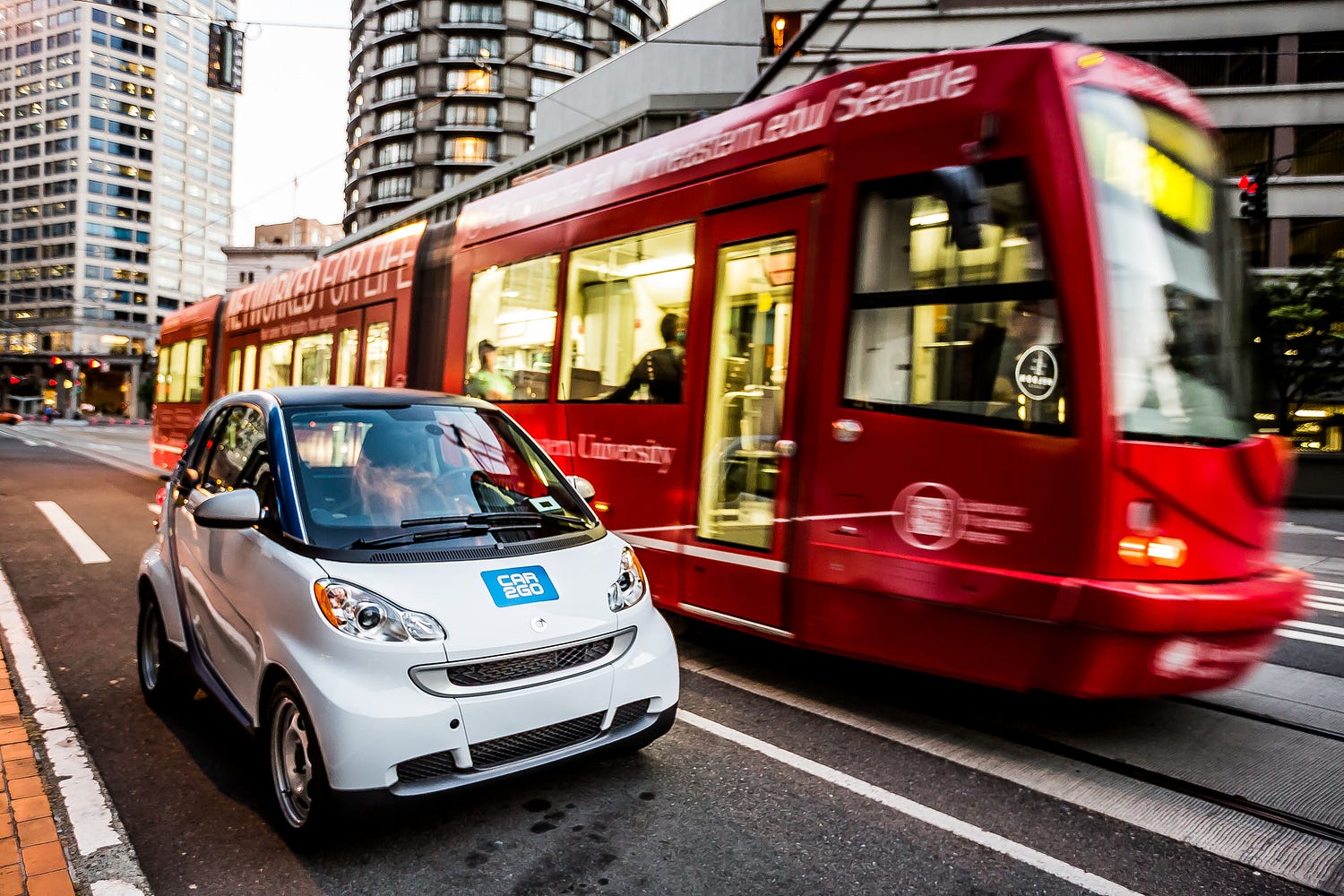A Trillion Bucks Says You’ll Sell Your Wheels
Todd Neff :: Rocky Mountain Institute :: 17 June 2016
Say goodbye to traffic congestion, parking problems, dirty gasoline… and car driving as you know it. Meet the new mobility, which RMI — with industry partners — is ushering in.
 |
| Image copyright Thinkstock / Rafal Olkis. |
Though driving is fun for some, for many it’s a simple necessity of getting where we need to when we need to. We pay dearly for that, whether we realize it or not. We spend tens of thousands of dollars — and plenty more on gasoline, maintenance, insurance, and taxes — for an asset that sits parked 95 percent of its life. Then, even though our cars can seat four or more people, we usually drive alone — 75 percent of American commuters are solo. There’s also the interminable traffic congestion, in which we spend an average 38 hours per year. And of course the air pollution from tailpipe emissions, accounting for ~20 percent of all U.S. carbon emissions.
This “privilege” doesn’t come cheap. Americans spend $1.2 trillion a year on our personal mobility — 20 percent of household incomes, on average. That equates to about $0.59 per mile, which adds up quickly when the typical American driver tallies ~13,500 miles per year. And none of those numbers include the additional $2 trillion or so annually that pollution, sitting in traffic, roads and parking lots, and accidents cost us.
But there’s a better way… one that can ultimately save $1 trillion of direct costs, 2 billion barrels of oil, and 1 gigaton of carbon emissions per year, according to Jerry Weiland, a 30-year veteran of General Motors and managing director of RMI’s mobility program. In this not-too-distant future, per-mile mobility costs are slashed from $0.59 to just $0.15. RMI views this opportunity as an enormous prize to be split among consumers, entrepreneurs, wise incumbents, and progressive cities.
The new mobility can save $1 trillion, 2 billion barrels of oil, and 1 gigaton of carbon emissions per year.
This new mobility builds upon RMI’s proud legacy of work on cost-effective, oil-free transportation embodied in the Hypercar concept, Winning the Oil Endgame, and Reinventing Fire. Expanding from the concept of more-efficient, better-designed vehicles, RMI’s team believes the future of mobility will look very different from its past. The confluence of several major trends is the front line of this fundamental mobility transformation.
On the societal front, the rise of peer-to-peer networks, smartphones, apps, and the sharing economy (think AirBnB, Uber, Lyft, Car2Go, ZipCar, and many others) are changing perspectives on whether we own and how we access and use assets like cars and houses. Plus, as a nation we’re driving less. Among Millenials there’s a distinct departure from the car-centric worldview of their Boomer parents, with vehicle ownership and even driver’s license rates on the decline. Meanwhile, total vehicle-miles traveled (VMTs) peaked in 2007, and per-capita VMTs have been declining even more sharply since.
Our vehicles are transforming too, seeming to come out of science fiction, and demonstrating a quantum leap from the internal combustion engine autos we’ve been driving until now: self-driving cars and electric vehicles like the Tesla Model S, Nissan LEAF, Chevy Volt, and BMW i3. Automakers already sell cars with parking automation, adaptive cruise control, lane keeping, and other driver-assist features. And incumbents plus new entrants such as Google and Apple have put millions of miles on self-driving vehicles, which are already legal on the roads in California, Nevada, Florida, Michigan, and Washington, D.C.
 |
| Car sharing and public transit are part of an urban transition to mobility as a service. Image courtesy of car2go North America. |
The sum of these trends is far greater than the parts, and point to a very different future of new mobility with four elements at the core.
The first is mobility as a service. “We’re going to share cars,” says Weiland. “They’re going to be running 12-hour days at very high levels of utilization.” Since the mobility is there when you need it and not when you don’t, it’s essentially “mobility on demand,” like streaming your favorite movie. And when you’re not committed to a single vehicle (the one you own in your garage today, perhaps) then the mobility-as-a-service perspective opens up all sorts of possibilities to you — walking, biking, Ubering, Lyfting, a self-driving car, buses, trains. The new mobility gets you where you want, when you want, how you want.
Underlying mobility as a service is using the right vehicle for the right job. Forget giant SUVs with third-row seats shuttling a single person. The vehicles of the future — a future that will take shape in the next five to ten years, the RMI team says — will be a diverse lot, built for diverse needs. Comfy one-seaters could carry commuters between their homes and bus or train stations, finally cracking the infamous “last-mile” problem that has long vexed transit planners. SUVs might carry people to the mountains or the beach, pickup trucks to Home Depot and back. Minibuses might make sense where big buses now trundle along mostly empty (and thus costing up to 90 cents a passenger mile in many municipalities, says Jonathan Walker, a manager in RMI’s mobility practice).
The vehicles of this future will also be electrified. Why? In a high-utilization mobility future — where fewer vehicles are driving more miles and more hours of the day — operating costs dominate their total cost. That’s one place where electric vehicles (EVs), with an average 120 MPGe, have a huge leg up over gasoline-burning cars, because their drastically lower “fuel” cost more than offsets their higher purchase price. And, since EVs also have far fewer moving parts, Weiland says they can go 300,000 or maybe even 500,000 miles, compared to 150,000 miles on the average late model car. The combination of robustness and low maintenance costs makes EVs ideal for high-volume shared services. That includes corporate fleets, where EVs can seriously trim a company’s operating costs and carbon footprint.
In the new mobility, much higher utilization rates mean we’ll need far fewer cars to move more people more efficiently in less traffic with less cost and less climate impact.
Then there are the aforementioned self-driving vehicles. At first blush, self-driving capability might sound like another cool feature. For maybe $10,000 — the Boston Consulting Group’s estimate for the added cost of that capability and the actual price of California startup Cruise Automation’s Audi self-driving add-on — you can let your car drive you. Catch up on the news, read a book, do some work, take a nap. But think about it: if the car can drive you, why have it just park itself and wait all day for you? Why not share it, let it transport others rather than sit parked waiting for you? Self-driving vehicles thus only further support mobility as a service provided through ubiquitous retail fleets, instead of individually-owned cars.
Finally, there’s mobility-friendly cities, says Greg Rucks, a principal in RMI’s mobility practice. Today’s urban landscapes are built around the automobile: streets clogged with traffic; drivers circling city blocks searching for parking; curbside, garage, and underground parking. Mobility-friendly cities, on the other hand, can trade excess road capacity and parking for more parks… or homes or shops or anything other than catering to the almighty automobile.
 |
| Image copyright Thinkstock / alexandragl1. |
The Journey of a Thousand Miles…
There are currently about 253 million registered cars and light-duty trucks on the road in the U.S. With a 2014 population of 319 million, that’s almost one car per person! That won’t be the case in the new mobility, where much higher utilization rates mean we’ll need far fewer cars to move more people more efficiently in less traffic with less cost and less climate impact. Of course, arriving at such a mobility Shangri-La won’t happen overnight, and it won’t be easy.
Weiland, Rucks, Walker, and the rest of the team believe we can reduce the number of urban/suburban vehicles on the road by up to 90 percent. Along the way, we will redefine cities and, probably, American life, just as the horseless carriage once did. The barriers will be formidable. Automakers, insurance companies, and other incumbents won’t be excited to cede 90 percent of a market, Weiland says, and would need to develop completely new business models to stay competitive — just as today’s electric utilities are facing with the rise of rooftop solar.
Psychology may prove a bigger hurdle than technology. People like the idea of being able to spontaneously take off somewhere in their own wheels, whether they do it very often or not. Plus, consumers may be slow to trust self-driving technology and reluctant to cede the steering wheel to a computer “brain” under the hood that’s wirelessly connected to the mobility world around it — even though self-driving cars are already safer than cars with human drivers. Data privacy could be a concern, too, though Rucks says the data at the heart of the new mobility would be anonymized. It’s not your personal secrets that matter, he adds, but rather “the aggregation of data in and across systems.”
“We have to devise a solution that’s 100-percent failsafe,” Weiland says. “The new mobility has to offer people a complete answer, not a partial one. Otherwise you’re not going to get rid of your car.” Or at least one of them as a starting point.
Nobody, the RMI team included, knows where exactly this all might go, and that’s not the point, Walker says. “We want to whet the appetite of businesses to go attack these trillion bucks,” he says. The road ahead looks very different from the one behind. But the question now is who will chart the course, who will come along for the ride, and who will be left standing on the side of the road.
Written by Todd Neff, a freelance writer who specializes in covering energy and climate. He wrote about retail electricity pricing in the Summer 2014 issue ofSolutions Journal.

No comments:
Post a Comment